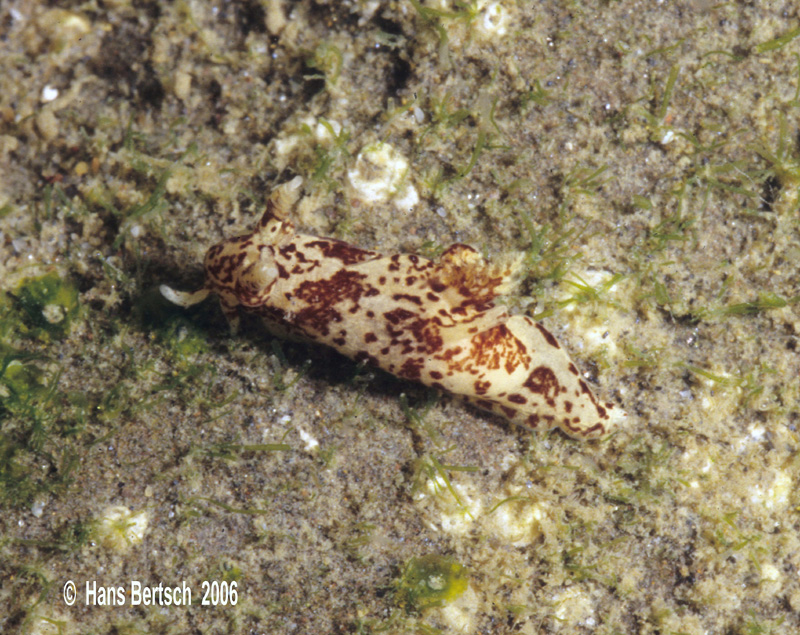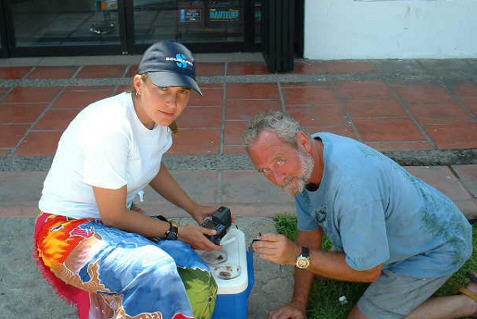 |
Trapania goddardi
Photo courtesy of Hans Bertsch
Trapania goddardi Hermosillo & Valdés, 2004
For almost a century, only one species of the genus Trapania Pruvot-Fol, 1931, has been known from the northeast Pacific: Trapania velox (Cockerell, 1901). The range of this species is from Carmel, California, USA, to Bahía Tortugas, Baja California Sur, México. In the past six years, three new species have been described from allopatric regions south of its range; these descriptions are obviously based upon the increased study efforts along the coasts of México (including the Gulf of California) and Costa Rica. These three species are: Trapania inbiotica Camacho & Ortea, 2000; Trapania goslineri Millen & Bertsch, 2000; and this week’s featured nudibranch, Trapania goddardi.
Hermosillo and Valdés state that the maximum length of the living animal is 7 mm. The body is smooth, lacking tubercles, and elongate, wider in the middle region. The border of the mantle is reduced. Each side of the body bears a digitiform extra-branchial process and a digitiform and posteriorly-curved extra-rhinophoral process. The non-retractile rhinophores are short and stout; they have no sheaths and bear 6–7 lamellae. The three branchial leaves are bipinnate and non-retractile. The anus closes the branchial circlet posteriorly. The digitiform oral tentacles are short, situated antero-laterally on the rounded cephalic region.
They describe the color of the body as variable from off-white with irregular small brown blotches on the middle and sides of the dorsum to tan with darker blotches. The density of the brown blotches can vary between individuals. There are two color variations: the clear and the dark forms. The ventral side of the body is off-white. The oral tentacles, rhinophores, branchial leaves, posterior end of the foot, and extra-branchial and extra-rhinophoral processes are the same color as the rest of the body, off-white with some brown spots.
The radular formula is 17 x 1.0.1 in a 7 mm long specimen. Detailed descriptions of the
internal anatomy (including SEMs of the radula and jaws, drawing of the reproductive system,
and photo of the egg mass) are presented in the
original description .
To date the species has been recorded only from Bahía de Banderas and Sayulita, Nayarit,
México. The opening photograph was taken of a specimen from Baja California; a note on this
range extension is in preparation. This species was named to honor fellow nudibranchologist (and larval development
expert) Dr. Jeff Goddard. Hermosillo & Valdés (2004: 558) state, “The three eastern Pacific species have a bright
white background color and are easily distinguishable from T. goddardi. Both T. velox and T.
goslineri have yellow markings on the oral tentacles, rhinophores, branchial leaves, extra-rhinophoral and extra-branchial processes, and on the dorsal portion of the posterior part of the
foot (Millen and Bertsch 2000). Similar yellow markings can be observed in T. inbiotica except
for the branchial leaves and rhinophores (Camacho and Ortea 2000) .Trapania goslineri has
black spots irregularly distributed over the entire body; T. velox has black lines and T. inbiotica
red spots (Millen and Bertsch 2000). On the contrary, T. goddardi has an off-white background
color, with various sizes and densities of brown spots, and it lacks black or red pigmentation.
Also, the rhinophores, branchial leaves, extra-branchial and extra-rhinophoral processes, oral
tentacles, and posterior end of the foot are the same color as the rest of the body, lacking yellow
markings. “Internally, Trapania goddardi is easily distinguishable from the other eastern Pacific
species of Trapania. The radula of T. goddardi is remarkably distinct by having an elongate and
curved cusp situated on the outermost edge of the lateral teeth. Trapania inbiotica has denticles
on the outer side of the cusp, a radular formula with 28 rows (Camacho and Ortea 2000), versus
17 in T.goddardi, and 21–24 inner denticles, many more than the 4–6 inner denticles of T.
goddardi. Trapania goslineri has two outer denticles, a smaller one followed by a more elongate
one; its radular formula is 37–41 and each tooth has 7–9 inner denticles. Trapania velox has a
radular formula of 22–32 rows, with a long outer denticle and 8–11 inner denticles on each tooth
(Millen and Bertsch 2000).”
This photograph shows Ali using her high-tech digital camera to photograph specimens collected. It was taken in front of the Buceo Vallartech dive shop (owned and operated by Roberto Chavez Arce), in Puerto Vallarta.
Hans can be contacted at hansmarvida@sbcglobal.net
Alicia can be contacted at gueri25@hotmail.com
Imperial Beach, California
Mar., 2006
Alicia Hermosillo and Hans Bertsch

Alicia is a Ph.D. candidate at the Universidad de Guadalajara, working on the ecology and taxonomy of opisthobranchs in Bahía de Banderas. Hans recently visited her, and was called "Buzo Clásico" (Classic Diver) because of his worn out and ancient equipment.
